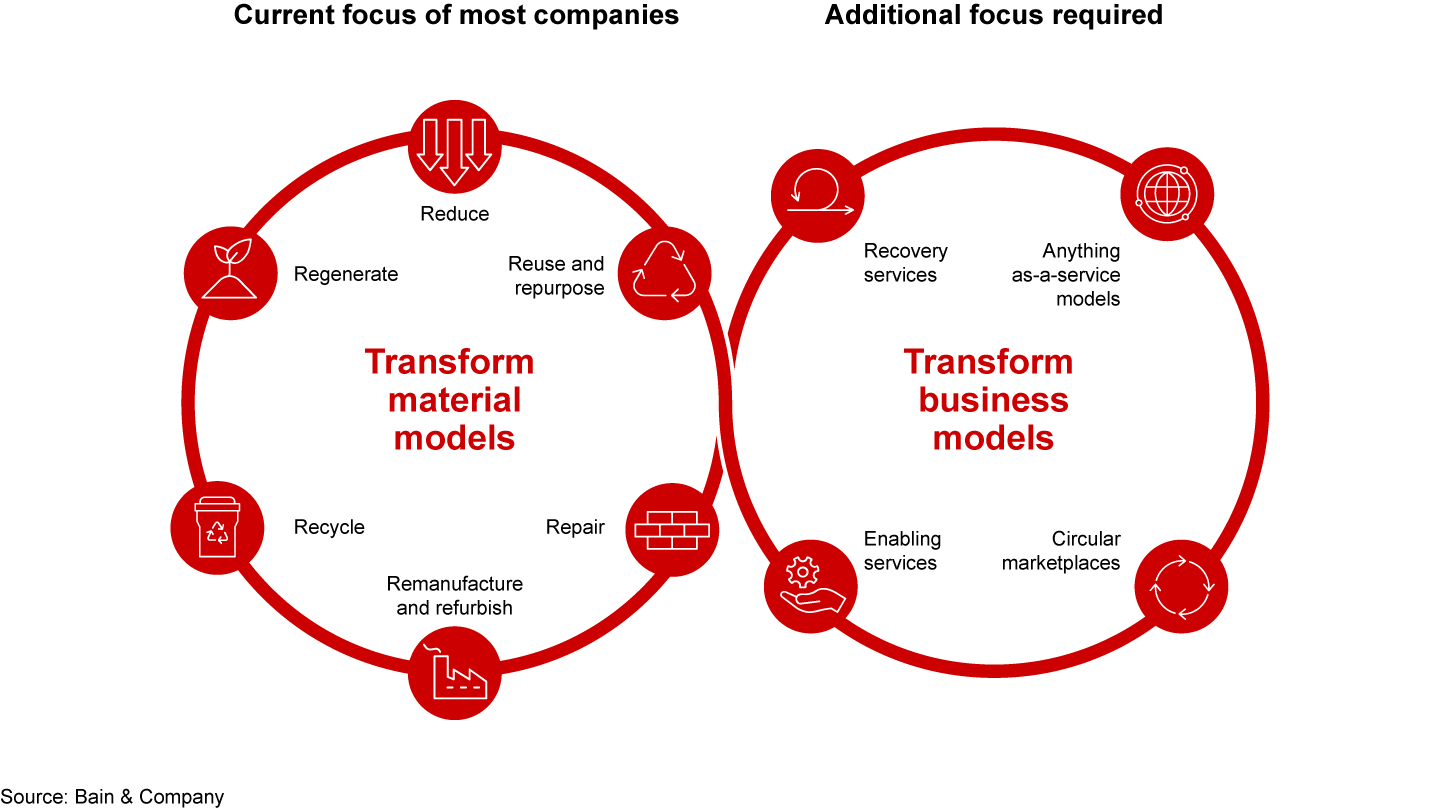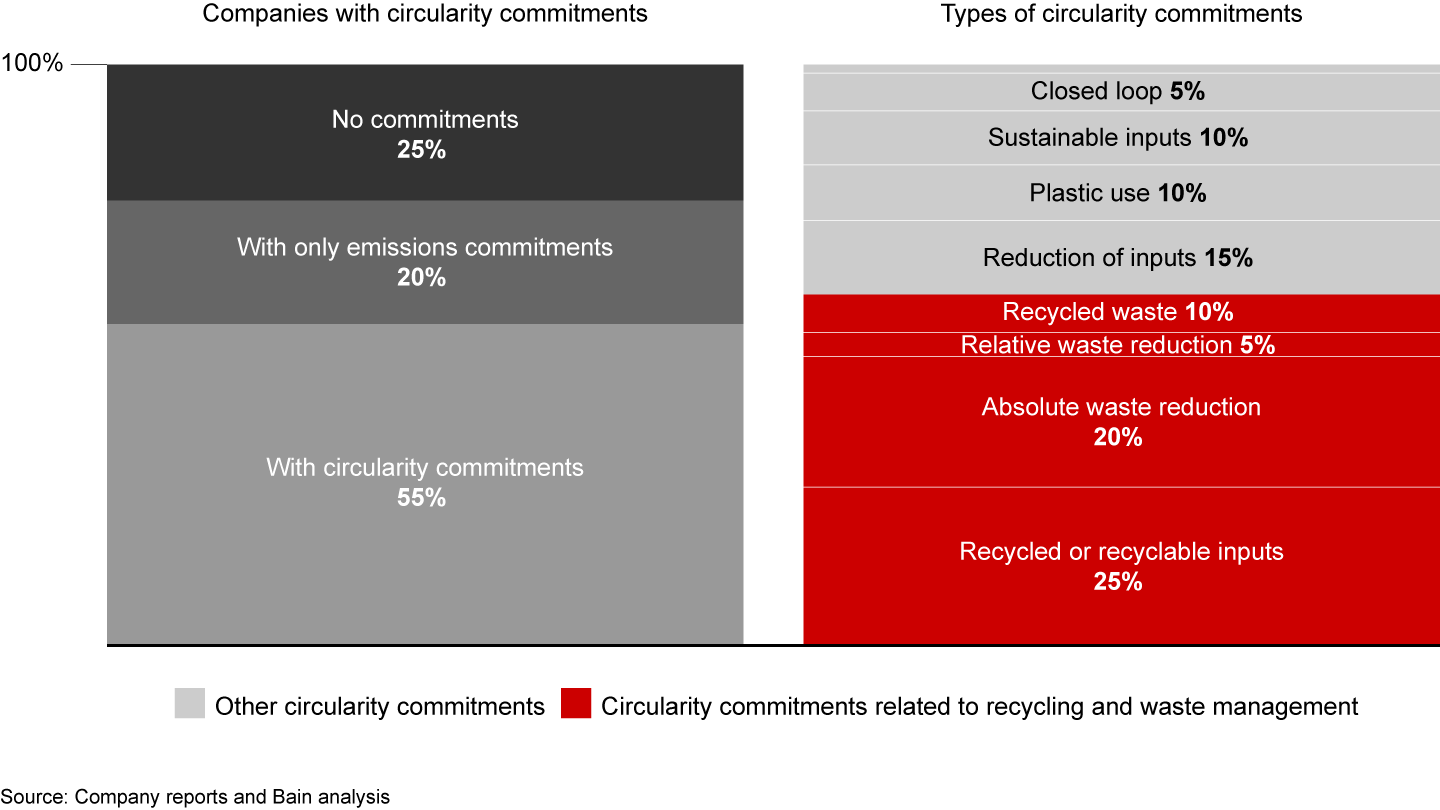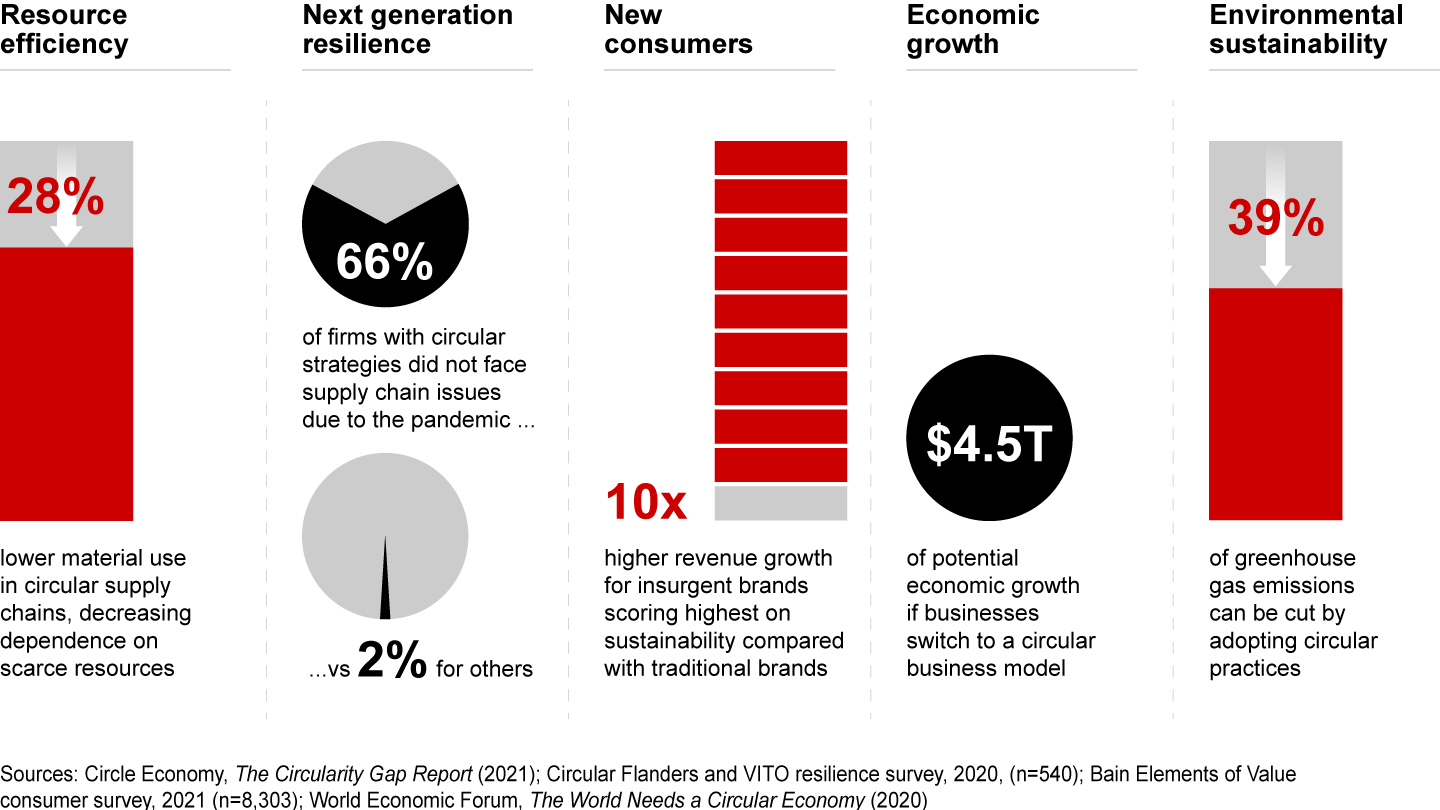Brief

At a Glance
- More than half of circularity initiatives are limited to recycling or waste management, a Bain study shows.
- As industries go circular, profit pools will shift, creating new opportunities.
- Companies that invest early in circular operating models and business models will have a first-mover advantage.
For many leadership teams, the transition to circular strategies and business models feels like rolling a huge stone uphill. They know it’s important, but progress is painfully slow. Initiatives remain narrow in scope, have limited impact, and are difficult to scale.
Part of the problem is that senior executives operate with a linear mindset. That’s understandable since today’s businesses were designed for a linear world. But to make the most of circular solutions, executives need to rethink how they run the business and decouple growth from resource consumption. That requires operating models and business models designed to preserve materials, increase product utilization, and extend product life spans (see Figure 1).

It’s a huge break with industry norms and best practices in the past century. Without new business models and reconfigured value chains, operations will remain linear and progress toward circularity incremental. A recent Bain study of 400 leading organizations found that while 55% had made commitments to circularity, more than half of the initiatives were confined to recycling or waste management (see Figure 2). Such efforts are laudable, but they will not spark a circular transformation.

To move beyond such narrow gains, some leaders are setting bolder ambitions, linking circular strategies to business objectives. Those objectives may include efficient use of resources, supply chain resilience, new market entry, revenue growth, and environmental sustainability.
These firms start by analyzing how and where the industry’s profit pools are likely to evolve. That allows executives to identify strategic opportunities and reimagine products, services, and value chains for a circular future. Shifting profit pools provide critical context for developing a circular strategy and for sequencing future investments based on signposts.
New sources of value
How can leadership teams learn to think about their business with a circular mindset when most executives have spent decades optimizing linear supply chains? The most effective approach is to view circularity as the foundation of long-term value creation as well as a short-term business goal. Leading companies are changing their mindset by imagining their industry as circular 15 to 20 years from now. That allows them to develop new strategies and business models for a circular world and launch concrete actions today that are stepping stones to the future.
Macroeconomic trends including scarcity of raw materials, trade tensions, environmental regulations, and global supply chain disruptions also are prompting leadership teams to pursue circular solutions with closed material loops. In the future, companies will design products for longevity, sell products as a service, and build on the sharing economy. These new business models can boost innovation, generate new sources of revenue, and reduce costs. They will also help firms manage material scarcity and increase supply chain resilience (see Figure 3).

Leadership teams that anticipate circular disruption will gain a significant first-mover advantage. By investing early, they will be able to influence how profit pools shift and shape them to their advantage. For example, companies investing in recyclable PET (polyethylene terephthalate) bottles also are investing in recycling infrastructure to improve their access to circular feedstock. Quicker and cheaper access to such feedstocks will give companies an edge in a circular industry.
Three sources of circular value can help executives assess a company’s efficiency in using virgin materials and a product’s circular performance: the virgin material consumption rate (relative to total inputs), product life span, and product capacity utilization. These elements have been widely used in environmental, social, and governance (ESG) research and reflect a generalized form of the Kaya identity equation.
The three sources of circular value also represent the areas of greatest potential profit pool growth—an optimum starting point for building a circular strategy.
Companies making disposable or short-life products, such as plastic bottles, or products containing scarce materials, such as smartphones, can create circular value by reducing the use of virgin materials and ensuring raw materials are recycled at the end of the product life span. For example, several fast-fashion companies are investing in new regenerative and recyclable fibers and fabrics to achieve these goals. Companies that aim to reduce virgin resource consumption may find growth opportunities in reverse logistics and infrastructure businesses or supplying circular feedstock.
The Coca-Cola Company partnered with local bottle recyclers and people collecting waste in Mexico to create a closed-loop ecosystem for recycled PET. Coca-Cola and its partners invested in critical technologies for extruding and decontaminating plastic so used bottles can be easily reused. That work enabled Coca-Cola to launch a 100% recycled PET bottle for its water brand Ciel.
Leaders are also applying circular strategies to products containing scarce resources. Apple, for example, developed disassembly robots to recover scarce materials like gold, cobalt, tungsten, and rare earth elements from used iPhones and other products. The company redeploys the collected materials in Apple products or sells them to other manufacturers. By 2025, Apple aims to use 100% recycled rare earth elements in all the magnets in its devices.
Extending a product’s life span is an effective strategy for high-value premium products that are both durable and easy to disassemble. For instance, Michelin is developing a tire retread business and tire-based services. It plans to offer fleet management companies retread tires with a range of services including on-site managers to perform health, safety, and maintenance checks.
Schneider Electric has used a modular design process to create Altivar process drives that can be refurbished, upgraded, reused, and recycled at the end of the first life cycle. According to Schneider, the modular design increases the life span of the product up to 20 years. Longer product life spans, in turn, will expand profit pools for specialized design firms, secondary marketplaces, and product authentication technologies.
Companies that make high-value products that require fast upgrades (or have short life spans) can increase product utilization by exploring different uses, sales models, and business models. Increasing product utilization can create growth in enabling services and platforms, reverse logistics and infrastructure, and service-and-leasing models.
Dell APEX, for instance, offers customized packages of hardware, software, and cloud storage as a subscription service. Dell says the program generates cost savings, digital resilience, and efficiency for the firm and its customers. A recent study by IDC found APEX customers’ three-year cost of operations declined by as much as 39%.
Spot the inflection points
A key challenge is determining when to implement a circular strategy. Successful companies anticipate changes to profit pools and typically invest ahead of the competition, but they are also careful not to invest too early. To get the timing right, these leaders monitor inflection points such as declining unit production costs and new regulations, as well as changes in consumer and customer behavior. Such signals can indicate an acceleration in the shift to circularity. Forward-looking executives also watch for the development of infrastructure to support circular industries.
Companies that track production costs and adoption rates, for example, will be in a better position to predict when circular models are ripe for scaling. These firms will among the first to identify the inflection points when new circular products and solutions are poised to become profitable and widely adopted.
To identify inflection points ahead of the competition, leaders track the experience curve (e-curve) of new circular solutions. E-curves show how unit production costs decline relative to increased production volume. Companies can use e-curves to forecast when circular solutions’ production costs will reach parity with those of legacy products and services.
E-curves can evolve in two ways. In the first scenario, circular solutions reach cost parity with legacy products, accelerating adoption. For example, as the infrastructure to collect and sort recycled PET grows, the cost to produce bottles with recycled PET nearly matches the cost of manufacturing bottles using virgin PET. That encourages consumer packaging companies to increase their use of recycled PET. Leaders in these markets will seek to move down the cost curve faster by pricing low to increase adoption.
In the second scenario, circular substitutes cost more than legacy products even after they reach large-scale distribution. To stimulate adoption, stakeholders (including governments) will need to incorporate the cost of external factors such as taxes on carbon emissions in legacy products to highlight cost parity. Excessive waste like single-use plastics can be banned or taxed. Governments also can create incentives to use sustainable resources such as green aluminum through subsidies and rebates.
In addition to e-curves, leaders also monitor the adoption curve (s-curve) of circular solutions. S-curves indicate the likelihood and trajectory of customer adoption. Key signposts include consumer awareness of the circular alternative, the existence of supporting infrastructure for circular services, availability of a broad portfolio of circular offerings, and customers’ willingness to change behavior. For example, in the electric vehicle industry, key signposts of consumer acceptance include OEMs’ growing portfolio of electric models and the development of charging infrastructure.
Identifying inflection points ahead of the competition allows leaders to scale production at the right time and define the circular business model for their value chains. It can also help incumbents stay a step ahead of circular insurgents—a key concern for executives developing circular strategies.
Changing market dynamics
Companies at the forefront of the circularity shift have begun identifying and investing in the new structures and processes required to replace linear business models. As these new market dynamics develop, industries will be able to go circular at a faster pace.
Importantly, the dynamics of circularity will also shift profit pools, negotiating power, and sources of control throughout the value chain, creating new winners and losers. A truck company that shifts to a leasing model, for example, will gain control over vehicles in the middle and at the end of their life span, while dealers and service providers lose control over those parts of the value chain.
Each of the three basic sources of circular value require different structures and processes to be cost-effective when deployed industrywide. Companies looking to significantly reduce the use of virgin materials, for example, will need steady access to recycled feedstock materials. Some will develop their own recycling infrastructure while others will enter partnerships. Companies that develop strategies to decrease the use of virgin materials will also overhaul their design process to make recyclable products. Those that lead the shift to recyclable products or processes will have a competitive edge as industries go circular.
Companies seeking to significantly extend a product’s life span will adapt their business models to engage customers after product purchase. One option is to develop modular designs that allow customers to make easy upgrades over time. Cloud service providers, for example, are asking equipment makers to design modular servers so components can be replaced more easily. Companies looking to increase product life spans also will develop economical repair options, including right-to-repair guarantees.
To achieve a substantial increase in product utilization, entire industries may shift to product-as-a-service business models, leading to changes in asset ownership and new financing structures. Technology OEMs that decide to lease hardware instead of selling it, for instance, will require more capital to support bigger balance sheets.
Companies leading the shift to circular industries will develop strong partner ecosystems to improve access to vital assets and capabilities. These partnerships will exist within and outside of a company’s value chain. For example, authorized treatment facilities (ATFs) such as scrapyards are a vital market structure for auto OEMs seeking recycled content and remanufactured components. Large ATFs in the European Union currently compete for a €150 million profit pool, which is forecast to double to €300 million by 2030. Manufacturers can partner with ATFs to remanufacture and refurbish components for new cars and benefit from a rapidly growing market.
Cross-industry communities such as the Circular Transformation of Industries launched by Bain & Company and the World Economic Forum are helping companies expand their circular ecosystems. These communities leverage the expertise and negotiating power of multiple value chains to develop the technologies, operating models, and policies needed for a circular economy.
Over the next decade, the shift to a circular economy will reconfigure profit pools in almost every industry. First movers will gain valuable competitive advantage by envisioning the change ahead of other companies, developing a circular strategy, and rapidly launching circular business models when the turning point comes.
As boards consider the shift to circular business models, a few key questions can help focus the discussion:
- How will your strategy and operations need to change as you transition from a linear model to a circular one?
- Where can a circular approach create value for the business, such as new customers, new sources of revenue, improved supply chain resilience, or access to scarce supply of raw materials?
- How is circularity likely to evolve in your value chain, and what inflection points will signal change?
- Where can you start collaborating with potential partners in the broader ecosystem?


